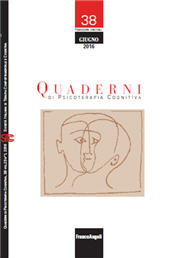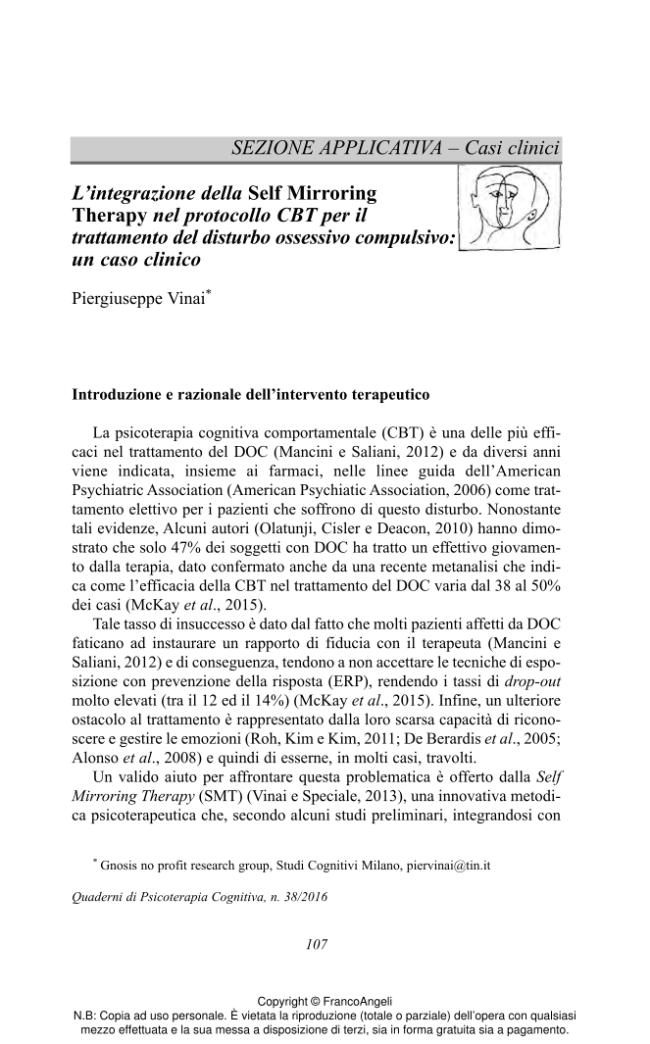L'integrazione della Self Mirroring Therapy nel protocollo CBT per il trattamento del disturbo ossessivo compulsivo : un caso clinico
107-116 p.
La terapia cognitiva comportamentale si è dimostrata essere il trattamento psicoterapeutico di maggiore efficacia nella cura del disturbo ossessivo compulsivo (DOC), con tassi di remissione del disturbo che variano dal 38 al 50% dei casi. Una delle maggiori difficoltà che s'incontrano nel trattamento di tale disturbo è la scarsa capacità dei pazienti affetti da DOC di riconoscere e gestire le loro emozioni. Un valido aiuto per affrontare questa problematica è l'integrazione della Self Mirroring Therapy (SMT) nei protocolli già validati per il trattamento del disturbo. Questo articolo, presenta il caso clinico di Marta, donna di 35 anni, affetta da disturbo ossessivo compulsivo e trattata con il "Modello cognitivo del disturbo ossessivo compulsivo" (Mancini, 2004, Il disturbo ossessivo compulsivo. In B. Bara, Manuale di Psicoterapia Cognitiva) integrato con la SMT. La terapia si è articolata in cinque fasi durante le quali sono stati trattati i differenti aspetti del disturbo attraverso la videoregistrazione d
egli ABC. Adistanza di sei mesi dalla fine della terapia, la paziente non ha più mostrato sintomatologia ossessiva e si è concessa di ascoltare le sue emozioni e di accettarsi con i suoi errori e le sue mancanze.
Cognitive behavior therapy have been proved to be the most efficient psycotherapeutic treatment for the obsessive compulsive disorder (OCD) with remission rate variating from the 38 to the 50% of the cases. One of the main difficulties encountered while treating OCD patients, it is the difficulty of this subject to recognize and deal whit their emotions. Avalid support to the treatment, it's the integration of the usual validated protocol with the Self Mirroring Therapy (SMT). This paper reports the clinical case of Marta, a 35 years old woman with obsessive compulsive disorder and treated with the "Cognitive Model of the Obsessive Compulsive Disorder" (Mancini, 2004), combined with the SMT. The therapy has been structured in five different stages, during which the different aspects of the disorder has been treated trough video registration of ABC. After six month from the end of the treatment, signs of the disorder were impossible to find in the patient behavior, who eventually allowed herself to listen her.
emotions and to accept herself the way she is, whit all her faults and defect.
Ist Teil von
Quaderni di Psicoterapia Cognitiva : 38, 1, 2016-
Artikel aus derselben Ausgabe (einzeln erhältlich)
-
Informationen
ISSN: 2281-6046
THEMENBEREICHE
KEYWORDS
- Self Mirroring Therapy, disturbo ossessivo compulsivo, neuroni specchio, alessitimia, psicoterapia cognitiva
- Self Mirroring Therapy, Obsessive Compulsive Disorder, Mirror Neurons, Alexithymia Cognitive Behavioral Therapy



